The NVIDIA GeForce RTX 2080 Ti & RTX 2080 Founders Edition Review: Foundations For A Ray Traced Future
by Nate Oh on September 19, 2018 5:15 PM EST- Posted in
- GPUs
- Raytrace
- GeForce
- NVIDIA
- DirectX Raytracing
- Turing
- GeForce RTX
Ashes of the Singularity: Escalation (DX12)
A veteran from both our 2016 and 2017 game lists, Ashes of the Singularity: Escalation remains the DirectX 12 trailblazer, with developer Oxide Games tailoring and designing the Nitrous Engine around such low-level APIs. The game makes the most of DX12's key features, from asynchronous compute to multi-threaded work submission and high batch counts. And with full Vulkan support, Ashes provides a good common ground between the forward-looking APIs of today. Its built-in benchmark tool is still one of the most versatile ways of measuring in-game workloads in terms of output data, automation, and analysis; by offering such a tool publicly and as part-and-parcel of the game, it's an example that other developers should take note of.
Settings and methodology remain identical from its usage in the 2016 GPU suite. To note, we are utilizing the original Ashes Extreme graphical preset, which compares to the current one with MSAA dialed down from x4 to x2, as well as adjusting Texture Rank (MipsToRemove in settings.ini).
| Ashes | 1920x1080 | 2560x1440 | 3840x2160 |
| Average FPS |  |
 |
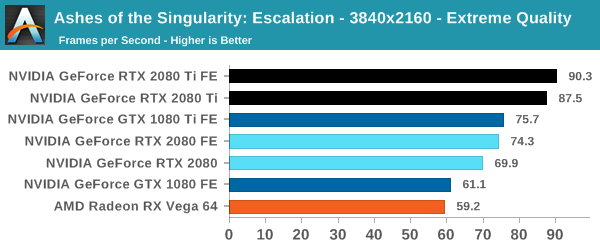 |
| 99th Percentile | 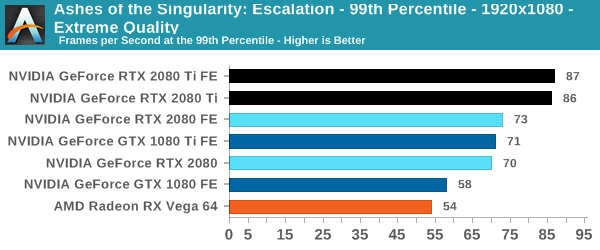 |
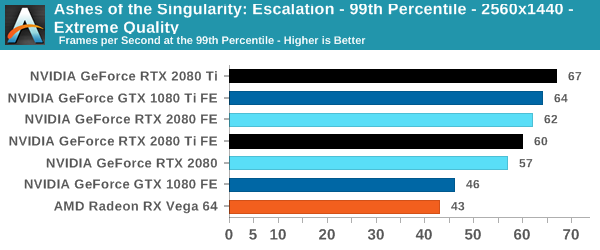 |
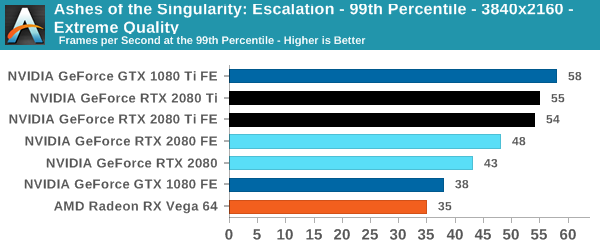 |
For Ashes, the 20 series fare a little worse in their gains over the 10 series, with an advantage at 4K around 14 to 22%. Here, the Founders Edition power and clock tweaks are essential in avoiding the 2080 FE outright losing to the 1080 Ti, though our results are putting the Founders Editions essentially neck-and-neck.


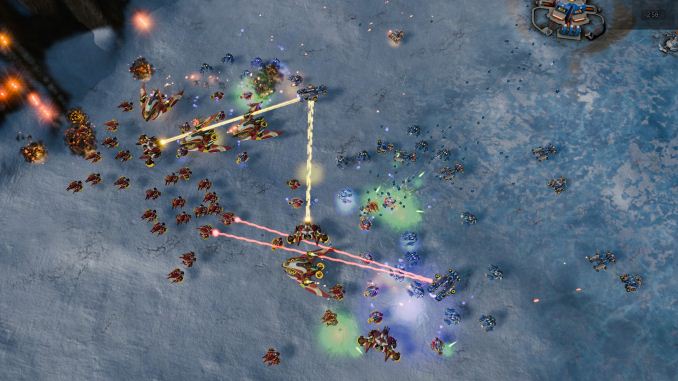









337 Comments
View All Comments
Billstpor - Friday, September 21, 2018 - link
Wrong. It's already known that the tensor cores have enough juice to run ray-traced effects and DLSS at the same time:https://youtu.be/pgEI4tzh0dc?t=10m55s
Vayra - Monday, September 24, 2018 - link
Wrong, the tensor cores need DLSS to run ray tracing at somewhat bearable FPS - that is, 30 to 60.DLSS is a way to reduce the amount of rays to cast.
Vayra - Monday, September 24, 2018 - link
Hence the non-existant improvement, or even worse position in terms of quality compared to SSAA x4 or better.In other words, running at native 4K is miles sharper and will perform miles better than a DLSS+RTRT combination still.
IUU - Sunday, September 23, 2018 - link
While your argument is solid, these days are just so weird that even $1200 cards seem to make a hell of a lot sense. This is also valid for similar desktop cpus.Why? Well , go buy a high-end iphone or a high end android phone... Enough said.
PS. For those who may use arguments like geekbench and such , it is just insulting to put it very very kindly!
Gastec - Thursday, September 27, 2018 - link
So basically buying high-priced electronics make sense because the companies selling them just increase the prices every year to make profits and a certain type of consumers are supporting those companies by purchasing no matter what the price (call them fanbois). The question is: Why, why are those people acting like that? What drives them?watek - Wednesday, September 19, 2018 - link
Consumers paying these premium prices for features that are not even fully developed or finished is mind boggling!! People are being bent over and screwed by Nvidia hard yet they still pay $1500 to be beta testers until next Gen.V900 - Wednesday, September 19, 2018 - link
Mindboggling? I suppose it would be for a time traveller visiting from the 19th century, but for everyone else it’s perfectly normal.There is always a price premium for those early adopters who want to live on the cutting edge of technology.
When DVD players came out, they cost over a 1000$ and the selection of movies they could watch was extremely small. When Blu-ray players came out, they also cost well over 1000$ and the entire catalogue of Blu-ray titles was a dozen movies or so.
And keep in mind, that the price that Nvidia charges for joining the early adopter club is really shockingly low.
When OLED or 4K televisions first came out, people paid tens of thousands of dollars for a set, and the selection of 4K entertainment to watch on them was pretty much zero.
With the 2080, early adopters can climb aboard for 600-1000$.
Games that take advantage of DLSS and RTX will be here soon and in the meantime they have the most powerful graphics card on the market that will play pretty much anything you can throw at it, in 4K without breaking a sweat.
It’s not a bad deal at all.
imaheadcase - Wednesday, September 19, 2018 - link
Again, two technology that have not even seen the real light of day, let alone to be proven worth it at all. Early adopters of the other techs you listed at least got WORKING TECH from the start as promised.V900 - Wednesday, September 19, 2018 - link
Ok, you’re either deliberately spreading untruths and FUD, or you just haven’t paid attention.There are games NOW that support RTX and DLSS. Games like Shadow of the Tombraidet, Control and PUBG.
And there are more games coming out THIS YEAR with RTX/DLSS support: Battlefield 5 is one of them.
The next Metro is one of many games coming out in early 2019 that also support RTX.
So tell me again how this is different from when Blueray players came out?
imaheadcase - Wednesday, September 19, 2018 - link
THose games you listed don't have it now, they are COMING. lol Even then the difference is not even worth it considering the games don't hardly take a hit for the 1080TI. You are the nvidia shill on here and forums as everyone knows.